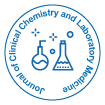
Journal of Clinical Chemistry and Laboratory Medicine
Open Access
ISSN: 2736-6588

ISSN: 2736-6588
Commentary - (2022)Volume 5, Issue 1
CPPs (Cell-Penetrating Peptides) are short peptides (less than 30 amino acids) that have mostly been used in fundamental and preclinical research throughout the last 30 years. CPP is unique and has different chemical properties due to differences in amino acid sequence, they each face unique challenges. They can transport tiny macromolecular medicines, nucleic acids proteins, viruses, and imaging agents through plasma membranes CPPs are a promising technique for tumour imaging. These imaging agents can be carried, transported, and delivered by CPPs, giving them intracellular access and capability. CPPs can be coupled to fluorophores, activatable probes, and radioisotopes.
Cell-penetrating peptides (CPPs), also known as protein transduction domains (PTDs), are short peptides (no more than 30 residues) that have been studied in basic and preclinical research for diseases such as cancer, inflammation, central nervous system disorders, octoprotective, ocular disorders, and diabetes. CPPs have been used to transport a variety of medicines, nanoparticles, and liposomes for disease diagnosis and treatment with great effectiveness. Because of their high binding affinity, compact size, specific uptake, high stability, quick clearance from non-specific targets, and retention in specific targets. For imaging tissues such as malignancies, as there is no single route for CPP translocation into a cell, many CPPs are taken up by a variety of cell types, making tumorspecific translocation difficult and hampering therapeutic effectiveness. Integrin-expressing malignancies, breast cancer cells, human histiocytic lymphoma, and protease-secreting fibrosarcoma cells are currently imaged using these approaches. CPPs can avoid many of the issues associated with conventional cancer treatment by delivering medications directly to tumours, reducing off-target side effects, a feat not presently possible with conventional chemotherapeutics. They can transport CPP/cargo complexes across cell membranes via various endocytosis pathways depending on the kind of CPP. CPPs are classified as protein-derived CPPs, synthetic CPPs, or chimeric CPPs based on their origins. Their properties include having particular patterns or helical shapes, protein-derived CPPs such as TAT and penetratin which can penetrate the cell, due to their excellent effectiveness in cellular absorption, polyarginine 8-10-mers are the most intensively investigated of this group, CPPs are chimeric in nature, they comprise sequences from two or more naturally occurring proteins, this group of CPPs is considered a transition from natural to synthetic CPPs. Amphipathic peptide is one example (CADY). CPPs are classified as linear or cyclic depending on their conformation. Cyclic CPPs have higher cell permeability and affinity with the cell's target receptor than linear CPPs resulting in improved Tran’s membrane ability via receptor-mediated uptake. CPPs are divided into three classes based on physicochemical differences: cationic CPPs, amphipathic CPPs, and hydrophobic CPPs. The positive charge of cationic CPPs displays strong affinity with the cytoplasmic membrane under normal physiological pH levels. Through electrostatic contact, the cationic CPPs join with the negatively charged cell membrane glycoprotein, which subsequently internalizes into the cell through a mechanism independent of the receptor. The amount and position of positively charged arginine’s in the CPP structure are the most important parameters affecting the activity of cationic CPPs. The majority of cationic CPPs have more than five positively charged amino acids. Amphipathic CPPs are the most frequent of the CPPs currently discovered, accounting for more than of all CPPs. The non-polar sections of amphiphilic CPPs are rich in hydrophobic amino acids, whereas the Polar Regions contain polar and nonpolar amino acid regions (for example, alanine, valine, leucine, and isoleucine). By precisely controlling trans membrane transport, CPPs are increasingly being used in drug administration and illness diagnosis. CPPs' ability to translocate across membranes proved crucial in the treatment of inflammation, central nervous system illnesses, ophthalmic disorders, and cancer. To determine the possible application value of CPPs coupled medications, basic research was conducted. The use of CPPs in preclinical investigations has yielded impressive results, demonstrating the limitless potential of CPPs-based therapeutics. Many concerns must be addressed before CPPs may be implemented in clinics. They have potential applications in disease diagnosis and therapy, including cancer, inflammation, central nervous system disorders, octologic and ocular disorders, and diabetes, because they are capable of not only trans locating themselves into cells but also facilitating drug or CPP/cargo complexes translocation across the plasma membrane.
Citation: Chen J (2022) Role of Cell-Penetrating Peptides in Cancer Diagnosis. J Clin Chem Lab Med. 5:202.
Received: 14-Jan-2022, Manuscript No. JCCLM-22-15885; Editor assigned: 17-Jan-2022, Pre QC No. JCCLM-22-15885; Reviewed: 01-Feb-2022, QC No. JCCLM-22-15885; Revised: 03-Feb-2022, Manuscript No. JCCLM-22-15885; Published: 11-Feb-2022 , DOI: 10.35248/JCCLM.22.05.202
Copyright: © 2022 Chen J. This is an open-access article distributed under the terms of the Creative Commons Attribution License, which permits unrestricted use, distribution, and reproduction in any medium, provided the original author and source are credited.